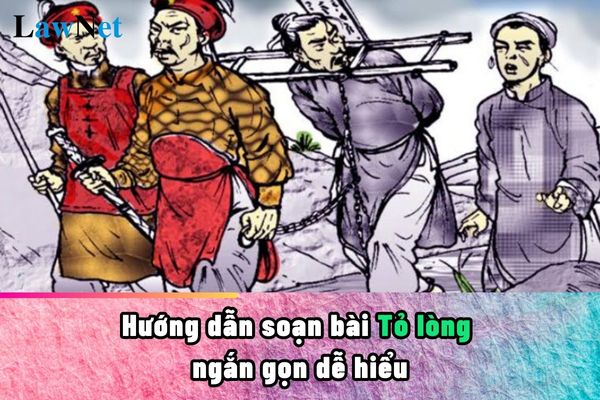What are guidelines on preparing the lesson "Tỏ lòng" for students in Vietnam? Does the literary knowledge of grade 10 students in Vietnam include the main inspirational content of the work?
What are guidelines on preparing the lesson "Tỏ lòng" for students in Vietnam?
The "Tỏ lòng" is one of the contents that students will learn in the Grade 10 Literature program.
Students can refer to the following guidelines for preparing the lesson "Tỏ lòng":
|
Guidelines on preparing the lesson "Tỏ lòng" *Structure and Artistry |
*Note: The information is for reference only./.

What are guidelines on preparing the lesson "Tỏ lòng" for students in Vietnam? Does the literary knowledge of grade 10 students in Vietnam include the main inspirational content of the work? (Image from Internet)
What requirements must grade 10 students in Vietnam meet when learning about literary texts in the Literature subject?
Based on Subsection 2 of Section 5 in the General Education Program for the Literature subject issued together with Circular 32/2018/TT-BGDDT, after studying literary texts in Grade 10, students must meet the following requirements:
(1) Content Understanding
- Be able to comment on the overall content of the text; analyze representative details, themes, stories, characters, and their relationships in the integrity of the work.
- Be able to analyze and evaluate the theme, ideology, message the text aims to convey to readers through the artistic form of the text; analyze some basis for determining the theme.
- Be able to analyze and evaluate the sentiments, emotions, and main inspiration that the writer expresses through the text. Identify moral and cultural values from the text.
(2) Form Understanding
- Recognize and analyze some elements of an epic, myth such as: space, time, plot, characters, narrator’s voice and characters’ speech,...
- Recognize and analyze some elements of a story such as: characters, story, third-person narrator (omniscient narrator), and first-person narrator (limited narrator) perspective, narrator’s voice, and characters’ speech,...
- Analyze and evaluate the aesthetic value of certain elements in poetry such as words, images, rhyme, rhythm, parallelism, lyrical subject, lyrical character.
- Recognize and analyze some elements of a cheo or tuong script such as: theme, anonymity, story stock, characters, dialogues, circulation method,...
(3) Connection, Comparison, Linkage
- Utilize the understanding of Nguyen Trai to comprehend some of his works.
- Recognize and analyze the historical-cultural context reflected in the literary text.
- Draw connections to see some similarities in content between literary works from two different cultures.
- State the significance or impact of the literary work on the reader's opinions, views, and feelings; express personal emotions and evaluations about the work.
(4) Extensive Reading
- In one academic year, read at least 35 literary texts (including texts guided to read online) with the genre and length equivalent to those studied.
- Memorize some favorite poetry excerpts or poems in the curriculum.
Does the literary knowledge of grade 10 students in Vietnam include the main inspirational content of the work?
Also, in Subsection 2 of Section 5 in the General Education Program for the Literature subject issued together with Circular 32/2018/TT-BGDDT, the literary knowledge of Grade 10 students includes:
- The main inspiration of the work
- The story, third-person narrator (omniscient narrator), first-person narrator (limited narrator), perspective in the story
- Some elements of epic, myth stories: space, time, plot, narrator, character, narrator's voice, and characters' speech,...; value and vitality of the epic
- Aesthetic value of some formal elements in poetry
- Some elements of folk cheo or tuong scripts: anonymity, theme, story patches, character, dialogue, circulation method,...
- Historical or cultural, social context and the work
- Basic understanding of Nguyen Trai helps in comprehending some of the representative works of this author
- The closeness in content between literary works from different cultural backgrounds
- Literary works and readers
Thus, according to the above regulation, the literary knowledge content for Grade 10 students will include content about the main inspiration of the work.

